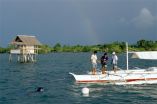(Press-News.org) OAKLAND, Calif., October 23, 2014 – Women who developed gestational diabetes and were overweight before pregnancy were at a higher risk of having daughters who were obese later in childhood, according to new research published today in Diabetes Care.
Based on long-term research that included a multi-ethnic cohort of 421 girls and their mothers (all members of Kaiser Permanente Northern California), the study is among the first to directly link maternal hyperglycemia (high blood glucose) to offspring being overweight later.
"Glucose levels during pregnancy, particularly gestational diabetes, were associated with the girls being overweight, and this association was much stronger if the mother was also overweight before pregnancy," said Ai Kubo, PhD, the study's lead author and an epidemiologist at the Kaiser Permanente Division of Research in Oakland, California.
The girls were part of the Cohort study of Young Girls' Nutrition, Environment, and Transitions (CYGNET), part of a National Institutes of Health-funded consortium examining early determinants of puberty.
"This research builds on our long-term study of pubertal development in girls, which has been underway since the girls were between 6 and 8 years old," said Lawrence H. Kushi, ScD, a study co-author and CYGNET Study principal investigator at the Division of Research.
The girls were followed from 2005 to 2011, with annual clinic visits to measure each girl's height, weight, body fat, abdominal obesity, and other parameters. Pregnant women in the Kaiser Permanente system take glucose tolerance tests during gestational weeks 24 to 28. Kaiser Permanente's comprehensive electronic medical records allowed researchers to link data collected on the girls to information about their mothers.
Twenty-seven mothers in the study had gestational diabetes. If a girl's mother had gestational diabetes, her risk of having a body mass index at or above the 85th percentile was 3.5 times higher than that of girls whose mothers did not have gestational diabetes. This association was independent of other important factors that influence girl's obesity, such as race/ethnicity, maternal obesity, and girl's pubertal stage.
Furthermore, the study found that if the girl's mother was also overweight and had gestational diabetes, her subsequent risk of being overweight was about 5.5 times higher. Similar associations were observed for a girl's increased body fat and likelihood of having abdominal obesity.
Kubo said the study suggests that behavior modifications in women to reduce weight gain and improve lifestyle before and during pregnancy may also help reduce the risk of obesity in their offspring.
INFORMATION:
Funding support for the study came from the National Institute of Environmental Health Sciences, the National Cancer Institute, and the National Center for Research Resources.
In addition to Kubo and Kushi, co-authors of the study were Assiamira Ferrara, MD, PhD, Charles P. Quesenberry, Jr., PhD, Cecile A. Laurent, and Anousheh S. Mirabedi, of the Kaiser Permanente Division of Research; Gayle C. Windham, PhD, California Department of Public Health; Louise C. Greenspan, MD, Kaiser Permanente San Francisco Medical Center; Julianna Deardorff, PhD, University of California, Berkeley; and Robert A. Hiatt, MD, PhD, University of California, San Francisco.
About Kaiser Permanente Division of Research
The Kaiser Permanente Division of Research conducts, publishes and disseminates epidemiologic and health services research to improve the health and medical care of Kaiser Permanente members and the society at large. It seeks to understand the determinants of illness and well-being, and to improve the quality and cost-effectiveness of health care. Currently, DOR's 500-plus staff is working on more than 250 epidemiological and health services research projects. For more information, visit http://www.dor.kaiser.org or follow us @KPDOR.
About Kaiser Permanente
Kaiser Permanente is committed to helping shape the future of health care. We are recognized as one of America's leading health care providers and not-for-profit health plans. Founded in 1945, our mission is to provide high-quality, affordable health care services and to improve the health of our members and the communities we serve. We currently serve approximately 9.5 million members in eight states and the District of Columbia. Care for members and patients is focused on their total health and guided by their personal physicians, specialists and team of caregivers. Our expert and caring medical teams are empowered and supported by industry-leading technology advances and tools for health promotion, disease prevention, state-of-the-art care delivery and world-class chronic disease management. Kaiser Permanente is dedicated to care innovations, clinical research, health education and the support of community health. For more information, go to kp.org/share.
DOWNERS GROVE, Ill. – October 23, 2014 – An international multicenter study reports that over-the-scope clip (OTSC) placement is a safe and effective therapy for the closure of gastrointestinal (GI) defects, which includes anastomotic leaks, fistulae and perforations. Clinical success was best achieved in patients undergoing closure of perforations or leaks when OTSC placement was used for primary or rescue therapy. The overall clinical success for the closure of perforations and leaks ranged between 90 percent and 73 percent; however, successful closure of ...
An ocean's oxygen levels may play a role in the impact of marine predators on bodies when they are immersed in the sea, according to Simon Fraser University researchers in a new study published this week in the journal PLoS One.
SFU criminologist Gail Anderson led the study, based on the deployment of a trio of pig carcasses into Saanich Inlet at a depth of 100 metres and studied over the past three years. Anderson assessed scavenger activity while co-author and SFU criminologist Lynne Bell continues her investigation of what happens to submerged bones.
The work is ...
Subjective screening questions do not reliably identify teenagers who are at risk for hearing loss, according to researchers at Penn State College of Medicine. The results suggest that objective hearing tests should be refined for this age group to replace screening questions.
The American Academy of Pediatrics, in partnership with the Bright Futures children's health organization, sets standards for pediatric preventive care. The AAP recommends screening adolescents with subjective questions and then following up with objective hearing tests for those found to be at ...
Just like those of humans, insect guts are full of microbes, and the microbiota can influence the insect's ability to transmit diseases. A study published on October 23rd in PLOS Pathogens reports that a bacterium isolated from the gut of an Aedes mosquito can reduce infection of mosquitoes by malaria parasites and dengue virus. The bacterium can also directly inhibit these pathogens in the test tube, and shorten the life span of the mosquitoes that transmit both diseases.
George Dimopoulos and colleagues from Johns Hopkins University, USA, had previously isolated Csp_P, ...
Orono, Maine — In the southern Peruvian Andes, an archaeological team led by researchers at the University of Maine has documented the highest altitude ice age human occupation anywhere in the world — nearly 4,500 meters above sea level (masl).
Their discoveries date high-altitude human habitation nearly a millennium earlier than previously documented.
Despite cold temperatures, high solar radiation and low oxygen conditions at that altitude, hunter-gatherers colonized the remote, treeless landscapes about 12,000 years ago during the terminal Pleistocene ...
LA JOLLA, CA – October 23, 2014 - Breaking carbon-hydrogen (C-H) bonds to alter existing molecules to create new ones is an increasingly important avenue for drug development. Of particular interest is mirror-image or "one-handed" compounds, but C-H breaking methods for making pure batches of these molecules have worked with only a limited range of starting materials.
Now a team from The Scripps Research Institute (TSRI) has established a new C-H activation technique that opens the door to creating a broader range of pure molecules of one-handedness or "chirality" ...
DURHAM, N.C. -- When pathogenic bacteria like Salmonella or Staphylococcus invade a host, the host organism should respond by going into a state of high alert, altering its metabolism to defend against the attack.
But if the host doesn't reverse course once the battle is won, its efforts will be wasted on defense rather than on repairing the damage done by bacterial invaders.
Duke University researchers have uncovered the genes that are normally activated during recovery from bacterial infection. The finding could lead to ways to jumpstart this recovery process and ...
Over the last decade, powerful new microscopes have dramatically sharpened biologists' focus on the molecules that animate and propel life. Now, a new imaging platform developed by Eric Betzig and colleagues at the Howard Hughes Medical Institute's Janelia Research Campus offers another leap forward for light microscopy. The new technology collects high-resolution images rapidly and minimizes damage to cells, meaning it can image the three-dimensional activity of molecules, cells, and embryos in fine detail over longer periods than was previously possible.
The developers ...
To protect our oceans from irreversible harm, governments, conservationists, and researchers around the world must address the enormous threat posed by unregulated and destructive fisheries, say top marine scientists.
In an article published today in Science, Prof. Amanda Vincent of Project Seahorse at the University of British Columbia and Dr. Jean M. Harris of Ezemvelo KZN Wildlife in South Africa call for bold new approaches to the pressing global issue of overfishing and habitat destruction, including networks of marine protected areas, co-ordinated governance, and ...
This news release is available in German. Viral infections always follow a similar course. The pathogen infiltrates the host cells and uses their replication and protein production machinery to multiply. The virus has to overcome the initial barrier by docking on the surface of the cell membrane. The cell engulfs the virus in a bubble and transports it towards the cell nucleus. During this journey, the solution inside the bubble becomes increasingly acidic. The acidic pH value is ultimately what causes the virus's outer shell to melt into the membrane of the bubble.
Capsid ...


